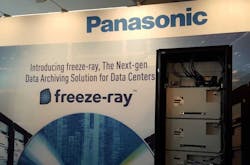SAN JOSE, Calif. – As we keep uploading photos every day, data storage is getting colder. When you want to fetch an old photo, there’s a growing chance it will be retrieved from a Blu-Ray disc by a robot.
An offbeat idea hatched in a lab at Facebook has now evolved into a new class of optical cold storage, with commercial products from two giants of the tech industry. The initial foray into Blu-Ray was an experiment to help Facebook manage a flood of incoming data, with users now uploading more than 900 million photos every day. To keep pace with all those uploads, Facebook must constantly seek new ways to add capacity.
At this year’s Open Compute Summit, both Sony and Panasonic showed off data archiving systems using robots to retrieve data stored on Blu-Ray discs. Sony Optical Archive Inc. unveiled the Everspan Library System, based on technology from its acquisition of Optical Archive, a startup founded by former Facebook executive Fran Frankovsky.
Just across the expo hall, Panasonic was demonstrating Freeze Ray Optical Data Archiver, which was developed with Facebook and tested in the company’s data centers.
These products are designed to provide a new alternative for companies seeking to store massive amounts of data in long-term storage archives. Both are based on Archival Disc, a new standard for professional storage discs developed jointly by Sony and Panasonic.
A key selling point for these products is the ability to lower the cost of data archiving, as Blu-Ray systems offer considerable energy savings, since energy is only needed when writing data during the initial burn. Blu-Ray cabinets don’t use energy when idle, but also require small amounts of power for the robotic systems that fetch disks.
Sony Everspan
Sony’s Everspan optical archive houses data in high-capacity Blu-Ray discs, which are retrieved by a robotic system. This enclosure was on display at the Open Compute Summit in March. (Photo: Rich Miller)
Blu-Ray is an optical data storage format that uses blue lasers to read a disk. It is best known as a medium for video players and gaming systems like the PlayStation and Xbox One, as the discs can store large amounts of data.
The Archival Discs used by Sony’s Everspan each hold 300 gigabytes of data, and each enclosure can hold 64 disks, with 8 lasers writing to the disks. Future generations of Blu-Ray media will be able to store up to 1 terabyte. The system is shipping to select customers already, and is expected to enter production next month.
The Everspan product suite consistes of three units: a base storage unit, a robotic unit, and expansion units. Up to 14 expansion enclosures can be tied together to create an archiving system with a capacity of 181 petabytes of data.
“We believe that Everspan addresses a large and rapidly growing need in the storage marketplace,” said Frankovsky, CEO of Sony Optical Archive Inc. “In a world where customers have been frequently forced into deciding which data to retain based on the ongoing cost of archiving, Everspan provides a welcome and affordable solution. It is our goal to make it possible for customers to store everything for as long as they wish in a low-touch, low-cost optical library.”
A close-up of the robotic disc retrieval system used by the Sony Everspan optical archiving solution, which was on display at the Open Compute Summit. (Photo: Rich Miller)
Sony says the full 181 petabyte will require only 9kW of power while operating, and just 2kW when idle. Everspan is offering a 100-year warranty. “Because of the durability of optical discs, unlike other storage media, users are expected to never need to migrate data,” the company says.
The system is shipping to select customers already, and is expected to enter production next month. One of the early adopters has been Los Alamos National Laboratory (LANL), which does high-performance computing for national security.
“LANL has evaluated the specifications of Sony’s Everspan optical storage library and are expecting to see significantly reduced recall times when dealing with extremely large files for analysis,” said Brett Hollander, LANL’s High Performance Computing Archive Lead. “LANL seeks to determine if optical storage will outperform both tape and hard drive technology in this usage model.”
Panasonic Freeze Ray
Panasonic’s Freeze Ray was developed in conjunction with Facebook. In June 2015 we saw an early version of the system in action at Facebook’s data center in Forest City, North Carolina, where the company operates one of its cold storage facilities for long-term storage of user photos.
Panasonic contributed the optical discs, drives, related robotics and library software to control the system in the data center. Facebook provided its unique expertise in deploying data center storage systems at massive scale.
A Blu-Ray cold storage devices inside a Facebook data center in Forest City, North Caroolina. (Photo: Rich Miller)
“We’re seeing exponential growth in the number of photos and videos being uploaded to Facebook,” said Jason Taylor, VP of Infrastructure for Facebook. “The work we’ve done with Panasonic is exciting because optical storage introduces a medium that is immutable, which helps ensure that people have long-term access to their digital memories.”
Facebook initially tested the system using 100 gigabyte discs. Panasonic was first to market in January with a system using the 100 GB discs. At Open Compute in March, it debuted an
“We think this solution will be very attractive to the data center industry,” said Yasu Enokido, President of Panasonic’s AVC Networks Company, who introduced the product at CSE 2016 in Las Vegas. “We plan to make these optical disc archivers an industry standard.”
About the Author



